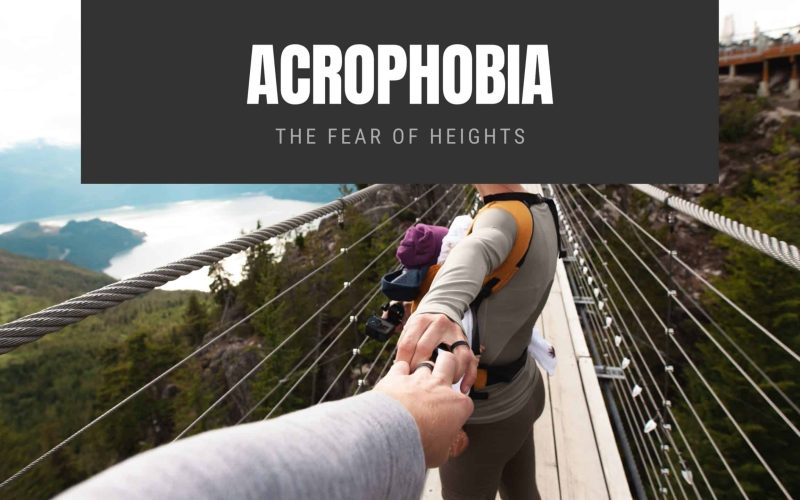According to some studies, acrophobia is one of the most common phobias people deal with. It describes a deep fear of heights that can lead to significant panic and anxiety.
Being scared or uncomfortable when standing or sitting in high places is not unusual.
For instance, the height may cause you to feel dizzy or nervous when you look down from a wheel at an amusement park or the top floor of a skyscraper.
However, these feelings may not make you panic or cause you to avoid heights altogether.
For people who have acrophobia, even the thought of crossing a bridge or viewing a video or photograph of a mountain and surrounding valley may lead to intense anxiety and fear.
This freight is not unreasonable and is generally fierce enough to harm your daily life.
If you or a loved one has acrophobia, read further to learn more about it and learn different ways to overcome it.
What Are the Symptoms?
There are several symptoms of acrophobia, but the main one is a deep fear of heights characterized by anxiety and panic.
For some people, going all the way to extreme heights triggers this deep-rooted fear.
For others, heights may trigger fear, including small stools and stepladders. This freight can lead to a wide range of psychological and physical symptoms. The Physical symptoms of acrophobia are;
- Increased sweating, heartbeat, and chest pain or tightness at the thought or sight of high places.
- Feeling nauseous or lightheaded at the thought or sight of high places.
- Shaking and trembling when in high places or viewing content that involves heights
- Feeling dizziness or imbalance (like falling or losing balance) when you look down from a high place or up at a high place.
- Doing all it takes to avoid heights, even if it affects your daily life negatively.
Psychological symptoms of acrophobia can include;
- Experiencing severe panic at the sight or thought of high places, or whenever you need to go up to a high place.
- Having an intense fear of getting trapped in a high place.
- experiencing severe fear and anxiety when you need to look out a window, climb stairs, or drive along an overpass
- Worrying excessively about the possibility of encountering heights at any time.
What Are the Possible Causes of Acrophobia?
Acrophobia may sometimes develop in response to a traumatic experience that involves heights. It could be as a result of experiences such as:
- Falling from great heights
- Watching movies that involve someone falling from a high place or seeing someone fall from great heights.
- Dealing with a panic attack or any other negative experience while watching people in a high place or at great heights.
However, many phobias, including acrophobia, can develop without an identified cause. In such rare cases, environmental factors or genetics may play a role.
For instance, you may have a more likely chance to suffer acrophobia if anyone else in your family has it. Or you developed a fear of heights from watching your caregivers behave like a child.
Evolved Navigation Theory
A phenomenon known as evolved navigation theory may also be a great way to explain why some people have acrophobia.
According to this unpopular theory, specific human processes, including the perception of height and depth, have adapted via natural selection.
It is believed that perceiving something as taller than it is can significantly reduce the risk of dangerous falls, thus increasing the possibility that you’ll live and reproduce.
How is It Diagnosed?
Most phobias, including the fear of heights, can be diagnosed only by a mental health professional.
If you do not have the contact of a psychiatrist, you can ask your doctor or any other healthcare provider for a referral to one. They can quickly help you get the diagnosis.
They will most likely begin by asking that you describe how you feel when you see people in high places or find yourself in great heights.
Make sure that you mention any other symptoms of mental health conditions that you’ve been experiencing and how long you have experienced such fears.
Generally, you will be diagnosed with acrophobia if you:
- Regularly avoid heights
- If you spend so much time worrying about finding yourself in great heights
- Find that the amount of time you spend worrying about height begins to affect your daily life
- Immediately react with deep fear and anxiety when you get in contact with great heights
- If you have experienced the mentioned symptoms for more than six months
How Can Acrophobia Be Treated?
Phobias do not necessarily require treatment in every case. For some types of phobia, avoiding the feared object is relatively easy and does not significantly impact their day-to-day activities.
However, suppose you discover that your fears are continually preventing you from doing most of the things you must do — such as going for official meetings in high places or visiting a friend or family member who lives on the most upper floor of a building. In that case, you may need to get treated.
Exposure Therapy
Exposure therapy is believed to be one of the best and most effective methods of treatment for some particular phobias.
In this type of treatment, the person with the phobia is required to work with a therapist to get moderate exposure to what they are most afraid of.
People dealing with acrophobia might begin by looking at images of a person inside a tall building.
Acrophobic people might watch video clips of individuals climbing, crossing a tightrope, or crossing narrow bridges.
Eventually, you may gather enough confidence to go onto a balcony or walk up a stepladder.
By the time you try to conquer your fears, you’ll have learned several relaxation techniques to help you maintain control and confidence in these moments.
Cognitive-behavioral Therapy (CBT)
If you are not comfortable enough to try exposure therapy, CBT may be of help. In CBT, you will be required to work with a therapist to challenge and reframe negative feelings and thoughts about heights.
This approach may still require a tiny bit of exposure to heights, but it is generally only done within the safe atmosphere of a therapy session.
Medication
There are no medications specifically designed for the treatment of phobias. However, some medications may help with symptoms of anxiety and panic, such as:
- Beta-blockers: These medications help keep your heart rate and blood pressure steady and reduce other physical symptoms of fear and anxiety.
- Benzodiazepines: These medications are sedatives. Such pills can help to reduce the symptoms of anxiety, but they are typically prescribed for only occasional use or for a short time as they can be quite addictive.
- D-cycloserine (DCS): This is a medication that may increase the results of exposure therapy. According to a study carried out in 2017 involving people who are dealing with several anxiety-related conditions, DCS was noticed to have helped with enhancing the results of exposure therapy.
Virtual Reality as a Method of Treatment
In the present decade, some experts have paid more of their attention to virtual reality (VR) as a likely method for treating phobias.
An immersive Virtual Reality experience can offer exposure to the object of your fear in a safe setting.
Exposure to computer software instead of going directly to the physical object allows you to stop immediately if things feel overwhelming.
A 2018 study focused on the effects of Virtual Reality on 100 people who have acrophobia.
Participants in the study experienced very low levels of discomfort during their VR sessions. In the end, many participants reported that VR therapy was useful and practical.
While the researcher pointed out that more studies are required in the field, they concluded that Virtual Reality might be an affordable and easily accessible treatment option since it can quickly be done at home.








